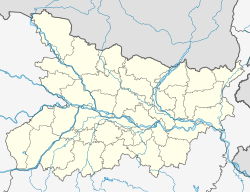Top Qs
Timeline
Chat
Perspective
Vishnudham Mandir
Vishnu temple in Samas village of India From Wikipedia, the free encyclopedia
Remove ads
Vishnudham is a significant Hindu temple located in Samas, Bihar,[1] notable for housing the second largest idol of Lord Vishnu in the world, reportedly surpassed only by the idol of Lord Venkatesh at Tirupati. The temple is situated in the Barbigha block of Sheikhpura district. The idol was discovered in 1992 in a pond adjacent to the temple site, where it had been buried for centuries.[2] The temple was constructed in the South Indian architectural style by local villagers and authorities at the site where the statue was discovered.
Remove ads
History
The idol of Lord Vishnu, which had remained concealed beneath the soil for an extended period, was unearthed on July 5, 1992, during the month of Ashadha, specifically on Shukla Panchami Sunday. Prior to its discovery, the idol was revered as the village deity known as 'Silbaba,' with only its aura visible to the villagers.[3] The unearthing of the idol attracted a large gathering of devotees, leading to the organization of a grand fair that lasted for three months. Following the discovery, the idol was installed with the assistance of local villagers, and formal worship commenced. Concurrently, the construction of the temple began, with visits from administrative officials for site inspections.[4][2]
Remove ads
Temple
Summarize
Perspective
The temple was subsequently placed under the jurisdiction of the Bihar State Board of Religious Trusts, similar to other prominent temples in the state. In 2007, the board urged the Bihar government to construct a temple inspired by the Tirupati temple in Andhra Pradesh.[1] The then Chief Minister, Nitish Kumar, pledged in 2009 to develop the temple as a tourist destination. However, the execution of this plan was realized only recently, in February 2025, with an allocation of ₹14.99 crores.[5][6] Currently, the idol is worshipped in a partially constructed temple by devotees.[7]
Idols
The idol of Lord Vishnu, which is the largest representation in the sthanakmudra posture[8] in North India, is crafted from black granite and measures 7.5 feet in height and 3.5 feet in width. This idol is believed to date back to the Gupta period, though some suggest it may belong to the Pala period. It has four arms, each holding a shankha, chakra, gada, and lotus. Beneath the left and right arms of the idol are two figures, one masculine and one feminine. [1] An inscription on the pedestal of the idol, written in ancient Devanagari script, reads 'ऊं उत्कीर्ण सूत्रधारसितदेव:'. This script exhibits evolutionary characteristics, with the shapes of the letters 'अ', 'इ', and 'ई' having developed from their earlier forms in Brahmi script. Scholars suggest that this style of script emerged in North India after the ninth century, with the Pratihara king Mahendrapala (891-907 AD) utilizing a similar script in the Dighwa-Duli donation inscription, which also references the sculptor Sitadeva.[9][10]
Along with it many other smaller idols were discovered which lies outside the garbhagriha in negligence. Many idols were also found in nearby areas many of which are kept in Jagadambaa temple.[11][12] It is also reported that a lakshmi idol was found in the 60s in the same area but it was stolen.[13]
Remove ads
References
Wikiwand - on
Seamless Wikipedia browsing. On steroids.
Remove ads
